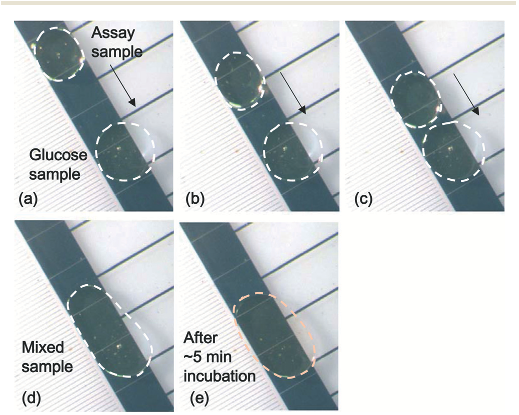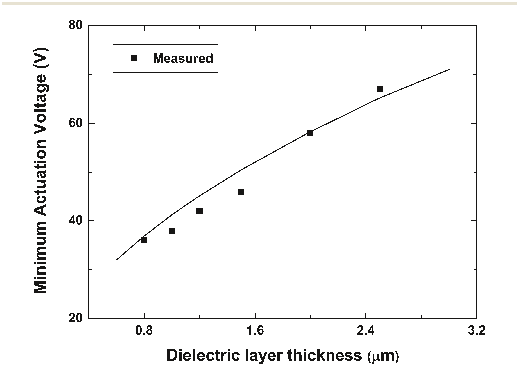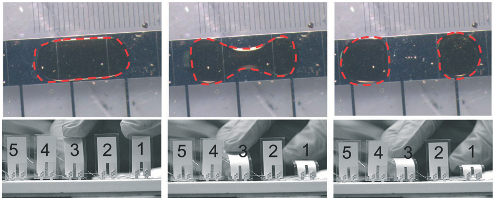
UCLA
UCLA Previously Published Works
Title
EWOD (electrowetting on dielectric) digital microfluidics powered by finger actuation.
Permalink
https://escholarship.org/uc/item/2nr7z58v
Journal
Lab on a chip, 14(6)
ISSN
1473-0197
Authors
Peng, Cheng
Zhang, Zhongning
Kim, Chang-Jin CJ
et al.
Publication Date
2014-03-01
DOI
10.1039/c3lc51223a
Peer reviewed
eScholarship.org Powered by the California Digital Library
University of California

Lab on a Chip
PAPER
Cite this: Lab Chip,2014,14,1117
Received 30th October 2013,
Accepted 17th December 2013
DOI: 10.1039/c3lc51223a
www.rsc.org/loc
EWOD (electrowetting on dielectric) digital
microfluidics powered by finger actuation
Cheng Peng,
a
Zhongning Zhang,
a
Chang-Jin “CJ” Kim
a
and Y. Sungtaek Ju
*
ab
We report finger-actuated digital microfluidics (F-DMF) based on the manipulation of discrete droplets via
the electrowetting on dielectric (EWOD) phenomenon. Instead of requiring an external power supply, our
F-DMF uses piezoelectric elements to convert mechanical energy produced by human fingers to electric
voltage pulses for droplet actuation. Voltage outputs of over 40 V are provided by single piezoelectric
elements, which is necessary for oil-free EWOD devices with thin (typically <1 μm) dielectric layers. Higher
actuation voltages can be provided using multiple piezoelectric elements connected in series when needed.
Using this energy conversion scheme, we confirmed basic modes of EWOD droplet operation, such as
droplet transport, splitting and merging. Using two piezoelectric elements in series, we also successfully
demonstrated applications of F-DMF for glucose detection and immunoassay. Not requiring power sources,
F-DMF offers intriguing paths for various portable and other microfluidic applications.
Introduction
Microfluidic devices are attractive for portable applications,
including point-of-care (POC) diagnosis, bio-surveillance, envi-
ronment sampling, and forensic science. They offer advantages
of low sample volume requirements and high reaction rates for
rapid analyses. However, most microfluidic systems require
bulky pumping and control systems as well as electrical outlets
to power them, limiting their field applications.
1
Previous studies proposed different approaches to
circumventing these challenges. Battery-powered microfluidic
devices with integrated microvalves and micropumps, for
example, have been reported for carrying out biological assays.
2
The resulting systems, however, were still too bulky for porta-
ble operations. “Passive” pumping mechanisms were also
explored. Paper-based microfluidic devices based on capillary
wicking attracted a lot of attention due to its perceived low
cost, lightweight and disposability.
3,4
Other passive pumping
mechanisms investigated include osmotic pressure,
5
built-in
vacuum
6
and human powered hydraulic pumping.
7,8
The fixed
layouts of continuous microfluidics employed in these devices,
however, limit their scalability and flexibility, making it diffi-
cult to adapt them on the fly to different protocols.
In digital microfluidics (DMF), droplets containing samples
or reagents are manipulated to carry out a range of discrete
fluidic operations. Precise control of individual droplets can be
achieved, thus providing greater flexibility and facilitating the
implementation of multi-step reactions.
9,10
The electrowetting on dielectric (EWOD) phenomenon
11
is
one of the most common actuation mechanisms used in
DMF and has been widely adopted in biomedical
12–16
and,
sometimes, other applications.
17,18
Traditional EWOD
devices, however, still require an external high-voltage supply
and switching circuitry, which require significant custom
development to realize compact systems.
19
We report EWOD-based DMF with finger-actuated voltage
generation on chip, or F-DMF, to eliminate the need for
external voltage sources. Fig. 1 schematically illustrates one
possible implementation of our device concept, which uses
an array of piezoelectric elements to convert mechanical
energy pulses provided by human fingers to voltage pulses.
Using this scheme, we confirmed basic modes of droplet
Lab Chip,2014,14,1117–1122 | 1117This journal is © The Royal Society of Chemistry 2014
a
Department of Mechanical and Aerospace Engineering, University of California,
Los Angeles, CA, USA. E-mail: just@seas.ucla.edu
b
Department of Bioengineering, University of California, Los Angeles, CA, USA
Fig. 1 Schematic of one implementation for the finger-actuated digital
microfluidic platform. The piezoelectric elements convert mechanical
energy imparted by human fingers to electrical energy to actuate droplets
confined between two parallel plates through the electrowetting on
dielectric (EWOD) phenomenon.
Published on 18 December 2013. Downloaded on 20/02/2014 17:10:00.
View Article Online
View Journal
| View Issue

1118 | Lab Chip,2014,14,1117–1122 This journal is © The Royal Society of Chemistry 2014
manipulation, such as transport, splitting and merging
of water droplets.
20
Furthermore, to demonstrate its capabil-
ity for biomedical applications, we successfully performed
the key assay steps involved in glucose detection and an
immunoassay.
EWOD device
Device design and fabrication
To successfully manipulate micro-droplets using EWOD, one
must generate voltage pulses of sufficient amplitude to over-
come capillary, inertial, and viscous forces. The EWOD-
induced contact angle change is related to the applied voltage
by the Lippmann–Young equation:
cos ( ) cos
V
t
V
0
0
LG
2
2
(1)
where θ
0
denotes the equilibrium contact angle at V =0V,ε
0
is the permittivity of vacuum, ε is the dielectric constant of
the dielectric layer separating the droplet from the electrode,
t is its thickness, and γ
LG
is the surface tension between the
droplet and surrounding. Since the contact angle change rep-
resents the actuation force along the surface, the higher the
applied voltage the stronger the actuation force that will drive
the droplet against the above-mentioned resistant forces.
Because the capillary resistance originated from the contact
angle hysteresis of an aqueous droplet surrounded in air
(as opposed to the popular oil environment) is larger than
the inertial or viscous resistance in most cases, performance
of EWOD devices is often measured in the air environment
without resorting to the filler oil or oil impregnation.
11
To
manipulate water droplets in air, typical EWOD devices
require a voltage source of about 40 V.
20
Our EWOD devices consist of two parallel glass plates that
were separated by approximately 100 μm. The bottom glass
plate contains an array of 1 × 1mm
2
gold electrodes, which
was fabricated using standard micro-fabrication processes.
We first deposited a 20 nm Cr/100 nm Au layer on a glass
wafer and patterned the layer by wet etching. Then, we depos-
ited a dielectric layer of silicon nitride by PECVD (plasma
enhanced chemical vapor deposition). We next spin coated a
solution of Teflon® AF (2% wt/wt in Fluorinert FC-40) at
2000 rpm for 30 seconds and baked it at 180 °C for
10 minutes to obtain a ~100 nm-thick hydrophobic topcoat. A
shadow mask was used to define electrical contact pads. The
top glass plate was coated with a transparent conductive ITO
(indium tin oxide, <15 ohm per square) layer to form a
counter electrode for EWOD. The counter electrode was also
coated with a ~100-nm-thick layer of Teflon®.
Due to the finite energy conversion efficiency of our piezo-
electric elements and safety consideration in portable appli-
cations, a low threshold actuation voltage and therefore a
thin dielectric layer is desired. However, a thin dielectric layer
is less robust and prone to pinholes and other defects, which
lead to electrolysis-induced failure of EWOD devices. The
dielectric layer thickness is further limited by the capacitance
allowed per EWOD electrode, which must be kept below that
of the piezoelectric element to minimize the voltage dividing
effect. With the above considerations in mind, we examined
SiNx layers of thickness ranging from 0.8 μm to 2.5 μmas
our dielectric layers. The estimated capacitance is approxi-
mately 60 pF per electrode for the EWOD devices with a
0.8 μm-thick dielectric layer, which is much smaller than that
of the piezoelectric element (~1 nF).
EWOD actuation voltage
To characterize the threshold actuation voltage required for
EWOD actuation as a function of the dielectric layer thick-
ness, an external programmable power source was used
to apply precisely defined voltage pulses. A water droplet of
~0.3 μL in volume was spotted onto the EWOD device and
subsequently split into two nominally identical daughter
droplets. After one of these droplets was positioned on one of
the electrodes, the amplitude of the voltage pulse applied to
the adjacent electrode was gradually increased until the drop-
let was successfully transported.
The threshold actuation voltage was recorded for each
dielectric layer thickness and the results are plotted in Fig. 2
(symbols). Also shown as a solid line in Fig. 2 are the voltages
required theoretically (eqn (1)) for the contact angle to
change from 120° to 70°, which is an empirically determined
range for droplet actuation in the given EWOD device. In
general, the threshold actuation voltage increases with the
increasing dielectric layer thickness. For EWOD devices with
a PECVD SiNx dielectric layer of thickness approximately
2.5 μm, a voltage as large as 70 V is required for successful
actuation of a water droplet.
Mechanical energy conversion
Piezoelectric elements of 13 × 25 mm
2
were used to convert a
mechanical energy input by human fingers into voltage
pulses to actuate micro-droplets in our EWOD DMF devices.
Fig. 2 Threshold actuation voltage of a water droplet on EWOD
devices as a function of the thickness of PECVD SiNx dielectric layers.
Lab on a ChipPaper
Published on 18 December 2013. Downloaded on 20/02/2014 17:10:00.
View Article Online

Lab Chip,2014,14,1117–1122 | 1119This journal is © The Royal Society of Chemistry 2014
Each piezoelectric element consists of a PVDF (polyvinylidene
fluoride) layer of thickness 28 μm (piezoelectric layer) lami-
nated on a polyester layer of thickness 125 μm (substrate layer)
as illustrated in Fig. 3(a) to maximize the average strain in the
piezoelectric layer and hence its output voltage. The length of
the piezoelectric layer, L
p
, is approximately 20.5 mm.
We modelled each piezoelectric element as an Euler–
Bernoulli beam. The element (beam) is mounted vertically
with the clamped end fixed. The bending angle, α(s), is
defined as the rotation of the piezoelectric element beam
measured in radians at distance s from the fixed end, as illus-
trated in Fig. 3(b). For a single piezoelectric element, the
open circuit voltage can be expressed as:
21,22
V
eh
S
s
0
31
1
p
(2)
Here, e
31
is the electromechanical coupling coefficient of the
piezoelectric layer, ε
s
is the permittivity of the piezoelectric
layer under a constant strain and h
p
is the thickness of the
piezoelectric layer.
The average strain, S
¯
1
, is defined as:
S
s
yys
Lh
yy
Lh
Lh
h
h
h
1
0
1
2
1
2
p
dd
d
pp
tip
pp
()
()
(3)
where h
1
and h
2
are the distances from the neutral axis of
the whole beam to the bottom and top of the piezoelectric
layer, respectively; α
tip
and α
0
are the bending angles, α(s), at
the tip and at the starting end of the piezoelectric layer,
respectively (Fig. 3(b)).
To characterize the energy conversion capability of our
piezoelectric elements, the open-circuit voltage outputs were
measured using an electrometer of input impedance >200 TΩ.
Optical images of the side views of the element were captured
to extract the bending angles along the beam.
Fig. 4 shows the measured and predicted output voltages
as a function of the tip bending angle, α
tip
, for a single piezo-
electric element. The prediction (straight line) agrees reason-
ably well with the experimental results (symbols) over the
entire range. Output voltages greater than 40 V, which are
sufficient to reliably actuate a water droplet in the EWOD
device with a ~0.8 μm-thick SiNx dielectric layer, can be gener-
ated at tip bending angles greater than 80°. However, larger
deformations may not be desirable for field operations and
may also lead to degradation of the piezoelectric elements. We
estimated that the force required to achieve a bending angle of
36, 70 and 108° is approximately 0.06, 0.12 and 0.18 N,
respectively.
If needed, multiple piezoelectric elements may be
connected electrically in series and mechanically in parallel to
increase the output voltage while limiting required deflection
to an acceptable range. Fig. 5 shows the total output voltage of
single and two or three piezoelectric elements connected in
series. The results are shown for three different bending
angles. At relatively small tip bending angles (~15°), the total
voltage output increases linearly with each additional piezo-
electric element. At larger tip bending angles (45° and 90°),
adding more elements does not lead to a proportionate
increase in the output voltage. This is in part due to asynchro-
nous bending of each element and in part to finite leakage cur-
rents. Nevertheless, we demonstrated that output voltages on
Fig. 3 (a) Cross section of the main functional layers of a laminated
piezoelectric element used in the present study; (b) definitions of the
length, L
p
, and the bending angle, α.
Fig. 4 Open-circuit output voltages of a single piezoelectric element
as a function of the tip bending angle.
Fig. 5 Total voltage outputs from multiple piezoelectric elements
connected in series under different tip bending angles.
Lab on a Chip Paper
Published on 18 December 2013. Downloaded on 20/02/2014 17:10:00.
View Article Online

1120 | Lab Chip,2014,14, 1117–1122 This journal is © The Royal Society of Chemistry 2014
the order of 100 V can be reliably generated using piezoelectric
elements connected in series with tip bending angles <90°.
EWOD actuation of micro droplets
Basic droplet operations
We next demonstrated successful finger-powered actuation of
water droplets on EWOD devices with 0.8 μm-thick PECVD
SiNx dielectric layers. An array of single piezoelectric ele-
ments is used to convert mechanical energy to voltage pulses.
Fig. 6 shows optical images of a single water droplet (~0.15 μL)
being transported over adjacent electrodes through a sequence
of finger-driven deflection of the piezoelectric elements. To
avoid a droplet being trapped on an inactive zone between two
adjacent electrodes, we delayed the release of the previously
bent piezoelectric element while deflecting the neighbouring
element. For example, referring to Fig. 6, element 2 was not
entirely released when element 3 was deflected, such that the
front contact line of the droplet would stay across the gap
between electrodes 2 and 3. For such a delayed release, a
holding force of approximately 0.06 N is sufficient.
We also demonstrated droplet splitting by simultaneously
deflecting two non-adjacent piezoelectric elements while
keeping the middle one non-deflected. Fig. 7 illustrates a
splitting of a water droplet (~0.3 μL) into two daughter
droplets of similar sizes through simultaneous deflection of
element 1 and 3. When splitting was in order, the droplet was
elongated in the longitudinal direction by a wetting force
exerted at the two ends while keeping the middle non-wetting,
as shown in Fig. 6. The actuation voltage on either side is
approximately 40–50 V, produced by one single piezoelectric
element with a bending angle <90°. For a large droplet that
covers multiple electrodes, asymmetric splitting can also be
achieved by simultaneously deflecting a set of piezoelectric
elements connected to the electrodes in an asymmetric man-
ner, for example, elements 1 and 3, 4. Fig. 8 shows a merging
of two droplets of similar sizes by asynchronous bending and
release of three piezoelectric elements (2, 4, and 3).
Applications to biological assays
As proof of principle demonstration of biological applications
of our F-DMF, we performed basic steps of glucose detection
and immunoassay. In these experiments, where higher
EWOD voltages are necessary to actuate droplets, we used
silicon nitride layers of thickness 2.5 μm because they help
prevent electrolysis of water under our low-frequency (~1 Hz)
finger-driven actuation scheme. Two piezoelectric elements
connected in series were used to provide an actuation voltage
of up to 100 V.
We demonstrated glucose detection based on an enzy-
matic oxidation, where the color of an assay solution changes
from clear to brown in the presence of glucose. Since the
reagent solution may chemically attack the hydrophobic coat-
ings, we pre-treated both the upper plate and bottom sub-
strate of our EWOD devices with silicone oil. A reagent
solution was prepared by adding 0.8 mL of o-dianisidine
reagent to an amber bottle containing 39.2 mL of a 1 : 5
horseradish peroxidase/glucose oxidase solution (15 units of
protein per mL of solution). We spotted a droplet of a 1 mg mL
−1
Fig. 6 Finger-actuated EWOD transport of a water droplet where
actuation voltage pulses were provided by bending a series of
piezoelectric elements.
Fig. 7 Finger-actuated EWOD droplet splitting. The piezoelectric
elements 1 and 3 are bent simultaneously for splitting.
Fig. 8 Finger-actuated EWOD droplet merging.
Lab on a ChipPaper
Published on 18 December 2013. Downloaded on 20/02/2014 17:10:00.
View Article Online








